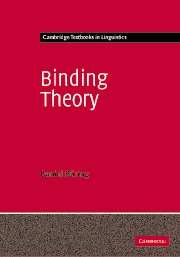Book contents
- Frontmatter
- Contents
- Preface
- 1 The ABC of Binding Theory
- 2 Interpreting indexed structures
- 3 Domains and orientation
- 4 Binding versus coreference
- 5 Other cases of semantic binding
- 6 The Coreference rule
- 7 Descriptive pronouns and individual concepts
- 8 Semantic binding and c-command
- 9 Plurals
- 10 Reciprocals
- 11 Exempt anaphora and reflexivity
- 12 Binding and movement
- Bibliography
- Index
4 - Binding versus coreference
Published online by Cambridge University Press: 05 June 2012
- Frontmatter
- Contents
- Preface
- 1 The ABC of Binding Theory
- 2 Interpreting indexed structures
- 3 Domains and orientation
- 4 Binding versus coreference
- 5 Other cases of semantic binding
- 6 The Coreference rule
- 7 Descriptive pronouns and individual concepts
- 8 Semantic binding and c-command
- 9 Plurals
- 10 Reciprocals
- 11 Exempt anaphora and reflexivity
- 12 Binding and movement
- Bibliography
- Index
Summary
In this chapter we will refine the interpretation procedure developed in chapter 2. An important distinction – that between coreference and binding – will be introduced, motivated, and technically implemented. An early and very lucid explication of the distinction is found in Bach and Partee (1980), so lucid, in fact, that I'll simply quote it:
Let's summarize the places where something like coindexing is used in the literature:
(1) The same pronoun appears in several places in a sentence:
He said he was OK.
(2) A pronoun appears together with a referring NP:
John said that he was OK.
(3) A pronoun appears together with a quantificational NP:
No woman doubts that she is OK.
(4) A pronoun occurs in a relative clause:
… the woman who said that she had found the answer.
(5) A reflexive or other obligatorily bound pronoun appears in a sentence:
John loves himself
Oscar is out of his head.
It is really only in situation (1) (in some sentences), and (2) that it seems appropriate to talk about coreference. In every other case (…) coindexing a pronoun with some other expression is a shorthand way of saying that the pronoun in question is being interpreted as a bound-variable …
Other authors have emphasized this point, too, in particular Tanya Reinhart (Reinhart, 1982, 1983a, b).
- Type
- Chapter
- Information
- Binding Theory , pp. 81 - 103Publisher: Cambridge University PressPrint publication year: 2005



